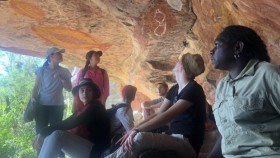The epidemic of myopia in East and Southeast Asia
In the 1990s, Ian Morgan was working on retinal neurotransmitters, including dopamine, in RSBS. Every now and then, he came across a paper suggesting that dopamine could slow eye elongation and prevent myopia. This led to the discovery of a fascinating story.
Firstly, myopia (or short-sightedness) is caused by an eye that grows too long, resulting in blurred images of distant objects. Secondly, although myopia was described as genetic, the prevalence of myopia in the developed countries of East and Southeast Asia had increased from about 10-30% to 80-90% in young adults. This didn’t make sense to Ian Morgan, because gene pools can’t change that fast. Thirdly, while most myopia is easy to correct, high myopia of -6D or worse, in which objects appear blurred when they are 16cm or more away, leads to pathological changes in the retina and potentially severe visual impairment, which cannot be corrected or prevented with glasses. Ian Morgan decided to address this important problem, through the use of animal models, and together with colleagues at the University of Sydney, initiated the Sydney Myopia Study.
In 2005, the group published a review arguing that the prevalence of myopia was increasing so fast that environmental/social factors had to be involved, and in 2008 the group showed that children who spent more time outdoors were less likely to become myopic. This was confirmed by comparing children of Chinese ancestry growing up in Australia and Singapore. The two groups had vastly different prevalence of myopia (3% in Australia compared to 27% in Singapore at the age of 6) and the children in Singapore reported less than one quarter of the time outdoors reported by those in Australia.
What is the impact of this research? Within a year, Singapore had adopted voluntary increased time outdoors as its national myopia prevention strategy, and, with a bit more evidence, in 2010 Taiwan adopted 2 hours per day in schools as a compulsory national program. In 2015, Ian Morgan was involved in a 3 year clinical trial in Guangzhou, China, that confirmed that increased time outdoors in schools reduces new cases of myopia. The results of the Taiwanese program are now showing that a 40-year pattern of declining vision in children has been reversed, and while there is still a long way to go, what looked like being a major health crisis, which could double or triple the level of blindness in older people, now looks as though it can be brought under control.
This article is one of a set featuring the achievements and memorable occasions in the History of Biology at ANU.








